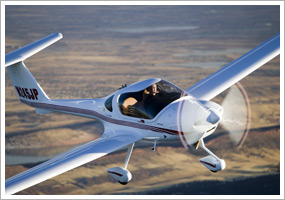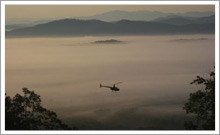Sept. 23, 2011, issue of 'AOPA ePilot: Flight Training Edition' newsletter
|
|
| ||||
| | FT News | INSIDE AOPA | TRAINING PRODUCTS | FINAL EXAM | |||
TRAINING TIPs Self-supervised solos Flight instructors may look at the same training program a little differently. Probably that first solo will still be there as a highlight. But another occasion likely to come in for honorable mention is when the instructor authorized you to solo when you were not under direct supervision. Unsupervised solos are an important stage for several reasons. It’s an obvious vote of confidence attesting that you will make careful, responsible choices about selecting your opportunities to make solo flights, and complying with limitations entered into your logbook for those flights. This occasion should be a major boost to your morale! Your ability to make unsupervised solos also adds flexibility to your training program. If your schedules are temporarily out of whack, making it difficult to set up some dual instruction sessions, you can still get out there and practice—avoiding prolonged delays that have a tendency to extend and set back training. Your instructor may now endorse your logbook for flight to an airport within 25 nautical miles of the airport where you normally train, for practicing landings and takeoffs, as prescribed by regulations. This would be a good time to review all regulations about solo flight. Also check the date of the required 90-day solo endorsement, noting that it must pertain to the specific make and model aircraft you will fly. Once you have earned this added freedom to fly solo, put the privilege to good use by planning practice goals for your flights that make best use of the time aloft. After each unsupervised solo flight, think about the “takeaways” you have gleaned from the experience. Do they confirm your understanding of a flight principle, procedure, or technique? Do they send you back to the books? There’s really no such thing as an unsupervised solo. Better, perhaps, to call it a self-supervised solo—another example of the supervisory skills discussed in the Sept. 16 Training Tip that you are learning as part of the overall process of assuming the responsibilities of a pilot in command.YOUR PARTNER IN TRAININGShort? Soft? Short and soft? Which type of specialized takeoff or landing is your favorite? Learn more about how to prepare for the days when you’ll encounter a runway that’s shorter than 4,000 feet and may have a soft green surface.
Did you know that student pilots who join AOPA are three times more likely to complete their flight training? Membership includes unlimited access to aviation information by phone (800/USA-AOPA, weekdays from 8:30 a.m. to 6 p.m. Eastern time) or from Flight Training Online or AOPA Online. If you're not already a member, join today and get the pilot’s edge. Login information is available online. FLIGHT TRAINING NEWSShifting the training paradigmOne year after its inception, the AOPA Flight Training Student Retention Initiative gathered more than 100 participants in Hartford, Conn., to discuss solutions to the declining pilot population. A start? Better business. Read more >> EAA, Sporty’s program creating new pilotsMore than 10,000 young people have progressed beyond introductory flights to pursue their aviation interests through a partnership between the Experimental Aircraft Association (EAA) and Sporty’s Pilot Shop. The five-step online EAA Flight Plan allows those who take Young Eagles flights to have free access to Sporty’s online training course, as well as a free EAA student membership, a free first flight lesson at a local flight school, and opportunities for numerous scholarships. Vaughn College, Redbird to partnerVaughn College and Redbird Flight Simulations will team up to develop a flight training program utilizing Redbird’s soon-to-be-opened Skyport facility in San Marcos, Texas. “We are confident that, using this innovative approach, we can graduate Vaughn students who are highly skilled, competent, safe pilots at a cost and within timelines that represent a real value to our students and their families,” said Vaughn President John Fitzpatrick. The first class of students will head to the facility for the spring 2012 semester. 17-year-old earns helicopter certificateIt’s always heartening to read of a 17-year-old becoming a pilot, the earliest age at which a private certificate can be earned. Less common is when the pilot in question is certified to fly rotorcraft. Adam Lev Gabay of Calabasas, Calif., became a helicopter pilot on Aug. 22. He flies a Robinson R22 based at Camarillo Airport, according to CalabasasPatch.com. Gabay’s father, Lahav Gabay, also is a helicopter pilot. Girls With Wings awards scholarshipKaitlyn Hollingsworth is the winner of the 2011 Girls With Wings scholarship, GWW Founder Lynda Meeks announced Sept. 6. Hollingsworth is the daughter of a pilot and works at an airport to be able to afford flight instruction. She received $1,000 to continue her flight training and said she wants to give back to the aviation community. Meeks said $500 of the award came from a donation from Flying High Coffee, which designates a portion of the profits from its coffee sales to aviation nonprofit programs. Obstacle departure procedures: Not just for IFR flightMany VFR pilots don’t learn about the IFR environment or charts until they begin their instrument training. But some IFR procedures—specifically obstacle departure procedures (ODPs)—have a place in every pilot’s toolkit. But what are they? An ODP is a set of instructions for getting you safely from the runway to a safe altitude. Sounds easy enough to do when you can see what's below you, but what about flying at night or in marginal VFR conditions? The terrain doesn’t care what you can or can’t see when departing. Find out more and test your knowledge of ODPs with the Air Safety Institute's safety quiz, sponsored by the AOPA Insurance Agency. Take the quiz >> Inside AOPAGo beyond ‘direct to’ with VFR GPS courseThese days, satellite navigation is so common that many pilots barely give it a second thought. Be that as it may, there’s more to using GPS well than just punching “direct” and following the magenta line. Before your next cross-country, be sure to check out the Air Safety Institute’s free GPS for VFR Operations course. You’ll get plenty of helpful tips on flight planning, learning your receiver, potential “gotchas,” and more. Get started >> AOPA Partnership Program: Making ownership more affordableAre you seeking a less-expensive path to aircraft ownership? The Aircraft Partnership Program can help you to find a partner—or as many partners as you’d like. Create a confidential Partner Profile that provides detailed information about the aircraft you want, including costs, location, availability, and more, and you’re on your way. Read more >> TRAINING PRODUCTSSporty’s Plates aviation app for iPadImagine carrying all U.S. terminal procedures and taxiway diagrams with you on every flight. That’s what you can do with the Sporty’s Plates app for the iPad. The app lets you search by airport identifier, approach type, or approach name. You can view by grid or list, and print charts if you need them. They’re considered a legal replacement for paper charts for FAR Part 91 flying. A year’s subscription is $49.95; you can try the app 30 days at no charge. Order online. Note: Products listed have not been evaluated by ePilot editors unless otherwise noted. AOPA assumes no responsibility for products or services listed or for claims or actions by manufacturers or vendors. FINAL EXAMQuestion: As we head into autumn and the sun begins to set earlier, I was thinking once again about flying more at night. Can you clarify what is considered “night” by the regulations?
Answer: According to FAR 1.1, “night” means the time between the end of evening civil twilight and the beginning of morning civil twilight, as published in the American Air Almanac, converted to local time. However, to meet the night takeoff and landing experience requirement in FAR 61.57(b), “night” is defined as the period of time beginning one hour after sunset and ending one hour before sunrise. For more information on flying at night, see AOPA’s subject report on night flying, as well as this Flight Training article.
Got a question for our technical services staff? Email [email protected] or call the Pilot Information Center, 800/872-2672. Don’t forget the online archive of “Final Exam” questions and answers, searchable by keyword or topic. WHAT’S NEW ONLINEWhen you advance the throttle, are you focused solely on getting airborne—or are you putting some thought into “what if” scenarios? Chip Wright discusses the considerations for a takeoff emergency in this week’s Flight Training blog. AOPA Career OpportunitiesEver dream of turning your passion for aviation into a career? We’re looking for a medical certification assistant, AOPA regional manager, associate editor–Web, associate editor–Web/ ePilot, production assistant–Web, application support engineer, .Net developer, aviation technical specialist, and manager of airspace and modernization. To learn more about other AOPA career opportunities, visit AOPA Online. Picture Perfect AVIATION EVENTS & WEATHER To include an event or to search all events in the calendar, visit AOPA Online. For airport details, including FBO fuel prices, see AOPA Airports. Flight Instructor Refresher ClinicsThe next Air Safety Institute Flight Instructor Refresher Clinics are scheduled in Baltimore, Md., Sept. 24 and 25; San Jose, Calif., and Nashville, Tenn., Oct. 1 and 2; Fort Lauderdale, Fla., and Indianapolis, Ind., Oct. 8 and 9; Windsor, Conn., Wichita, Kan., and Columbia, S.C., Oct. 15 and 16; and Corpus Christi, Texas, Oct. 29 and 30. For a complete schedule, see AOPA Online.
Can’t make it in person? Sign up for the CFI Refresher Online. Air Safety Institute Safety SeminarsAir Safety Institute Safety Seminars are scheduled in Reno, Nev., Sept. 26; Sacramento, Calif., and Gaithersburg, Md., Sept. 27; Milpitas, Calif., Sept. 28; Santa Monica, Calif., Morristown, N.J., Pittsburgh, Pa., and Weyers Cave, Va., Oct. 3; East Hartford, Conn., Hopkinsville, Ky., New Cumberland, Pa., and Manassas, Va., Oct. 4; Frankfort, Ky., Woburn, Mass., Allentown, Pa., and Richmond, Va., Oct. 5; Manchester, N.H., King Of Prussia, Pa., and Hampton, Va., Oct. 6; Garden City, N.Y., Oct. 10; Colorado Springs, Colo., and Poughkeepsie, N.Y., Oct. 11; Denver, Colo., West Lafayette, Ind., and Cohoes, N.Y., Oct. 12; and Milan, Ill.,and Brockport, N.Y., Oct. 13.
Topics vary—for details and a complete schedule, see AOPA Online. | Advertisers Got news? Contact ePilot. Having difficulty using this service? Visit the ePilot Frequently Asked Questions now at AOPA Online or write to [email protected]. |
| Member Tools : Send feedback | ePilot Archive Editorial Team: ePilot Flight Training Editor : Jill W. Tallman | ePilot Editor: Sarah Brown | Contributor: Alton K. Marsh |

 Ask any number of newly certificated private pilots to identify the high points of their training. It’s certain that all will mention their first solo and the day they passed their checkride. Few other milestones match those moments.
Ask any number of newly certificated private pilots to identify the high points of their training. It’s certain that all will mention their first solo and the day they passed their checkride. Few other milestones match those moments.


